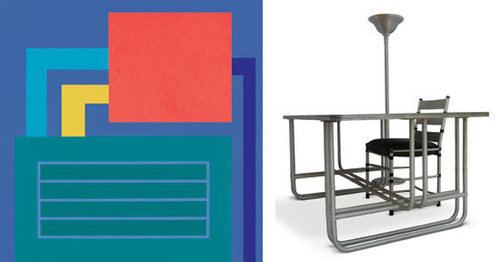Peter Halley / Warren McArthur
dal 13/7/2007 al 11/8/2007
Segnalato da
13/7/2007
Peter Halley / Warren McArthur
Rohrer Fine Art, Laguna Beach
Halley's paintings consist of brightly-colored blocks of color embedded among rectangles and squares of contrasting colors, which he calls 'prisons' or 'cells'. His work is therefore a direct reaction to the modernist ethos of McArthur's furniture, which valued economy, speed and cost efficiency. The simple and elegant curves of anodic aluminum were joined by McArthur's own invention to create support structures for sofas, chairs and other type of furniture.

New Paintings / Aluminum Furniture
curated by Chip Tom
Rohrer Fine Art is pleased to present an exhibition of new work by the internationally-renowned painter Peter Halley, alongside aluminum furniture by mid-century master Warren McArthur. The exhibition opens with a reception July 14 from 5 to 7pm and runs through August 12. The artist will be in attendance at the opening reception.
Peter Halley’s paintings consist of brightly-colored blocks of color embedded among rectangles and squares of contrasting colors, which he calls ‘prisons’ or ‘cells.’ Halley has painted in this post-minimalist style since the 1980’s when he and a group of his contemporaries, dubbed ‘Neo-Geo,’ began painting pure geometric forms reacting against and referencing earlier generations. According to art historian Robert Hobbs, in reference to these earlier generations, such as the Suprematists, “Halley seeks to bring [these lofty concepts] down to earth so that their geometric forms can be understood as part of the overall coerciveness of industrialized societies oriented to the geometry of assembly-line production, city blocks, housing units, and prescribed avenues of communication and attuned as well to the abstractness of capitalist administrations.”
Halley’s work is therefore a direct reaction to the modernist ethos of McArthur’s furniture, which valued economy, speed, labor-saving construction methods and cost efficiency. The simple and elegant curves of anodic aluminum were joined by McArthur’s own invention to create support structures for sofas, chairs and other type of furniture. He also patented a process that allowed him to treat the porous aluminum with mineral dye, actually sealing the surface of the aluminum with color. McArthur’s furniture was quickly adopted by the transportation industry for use on ships, planes and trains, because it was functional and light weight. At the same time it graced the theatres and hotels of Hollywood as it exuded the glamour associated with the 1930’s Art Deco movement. All the pieces in the exhibition will be for sale. This exhibition is curated by Chip Tom and the Warren McArthur furniture is courtesy of Nick and Shaunna Brown.
Opening july 14, 2007
Rohrer Fine Art
346, North Coast Highway - Laguna Beach
Free admission



